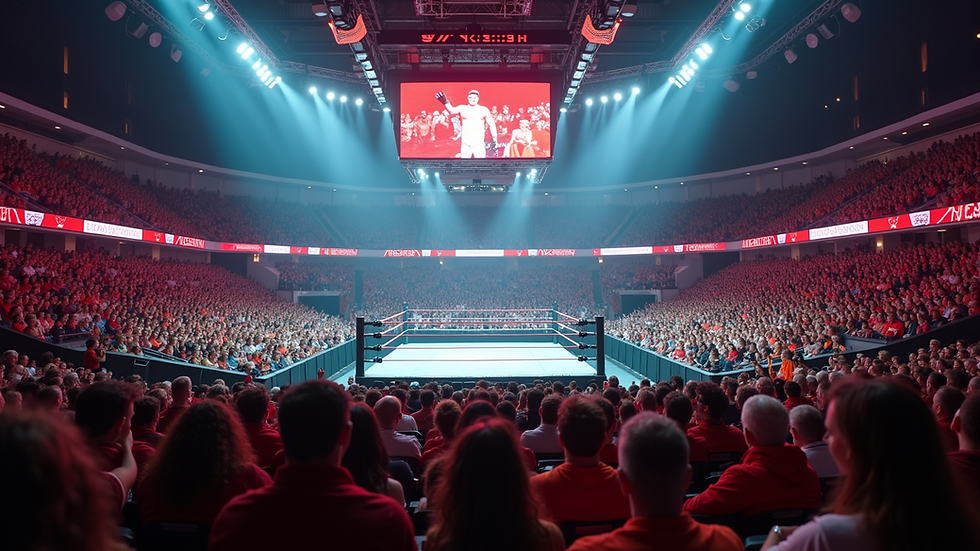Wrestling Showdown: What's the Real Difference Between Pro and Amateur Styles?
- kennyherrholz

- Jun 4, 2025
- 5 min read
Pro wrestling and amateur wrestling share the same name but represent two vastly different worlds. Both forms of wrestling involve grappling and competition, yet they have different goals, rules, and training styles. This article explores the key differences between pro and amateur wrestling, delving into their techniques, training, audience engagement, and cultural impact. Whether you are a dedicated wrestling fan or just curious, this breakdown will help clear up the differences.
Understanding the Basics
Before exploring the differences, let's briefly define pro and amateur wrestling.
Amateur wrestling is a competitive sport centered around grappling techniques, weight classifications, and a scoring system based on points awarded for moves and positions. It is commonly seen in schools, colleges, and during Olympic events. The focus is on athletic skills and strategic thinking.
In contrast, pro wrestling is centered around entertainment. Matches are scripted, with predetermined outcomes, allowing for storytelling and character development. While pro wrestlers train hard, the key focus is on entertaining the audience rather than on traditional competition.
The Objective: Wins vs. Entertainment
Amateur Wrestling: The Quest for Victory
In amateur wrestling, the objective is simple: outscore your opponent or pin them for a win. Competitors train hard, focusing on perfecting their techniques and enhancing their physical strength. A high school wrestler can spend up to 20 hours a week training, practicing everything from takedowns to escapes.
For instance, in a typical wrestling match, points may be awarded as follows:
2 points for a takedown
3 points for a near fall
1 point for an escape
These scoring opportunities emphasize strategic movements, making every point crucial to secure victory.
Pro Wrestling: The Show Must Go On
Pro wrestling revolves around storytelling, character arcs, and dramatic performances. Wrestlers showcase their skills, but the primary aim is to entertain. Each match is choreographed to create a captivating narrative that keeps audiences engaged.
For example, major events like WrestleMania attract over 70,000 fans and millions of viewers globally. The storylines often feature twists and turns that can develop over months or even years, drawing audiences into the drama of their favorite wrestlers.
The Training Regimen
Amateur Wrestling: A Focus on Fundamentals
Amateur wrestling involves intense training focused on physical and tactical skills. Aspiring wrestlers often begin as young as six, learning styles like Greco-Roman or freestyle. Their training includes:
Technique Drills: Grappling skills and executing moves are refined through repetition.
Conditioning: Wrestlers engage in strength training, cardio, and flexibility workouts to boost performance.
Competition Experience: Regular matches help wrestlers gain experience and confidence.
Many collegiate wrestlers, for instance, have to balance their rigorous training schedules with academics—often dedicating an impressive 30 hours a week to both practice and study.
Pro Wrestling: Versatility and Performance Art
In contrast, pro wrestling training involves a mix of skill development and performance art. Wrestlers learn how to:
Choreograph Matches: Wrestlers collaborate to design matches that are physically impressive and entertaining.
Character Development: Wrestlers create unique personas that resonate with fans. For instance, The Undertaker is known for his dark persona and elaborate theatrics.
Promote Themselves: Skills in interviews and social media engagement are crucial for building a fan base.
While strength is vital, the ability to engage an audience through performance and storytelling is equally important in pro wrestling.
The Rules and Regulations
Amateur Wrestling: Structure and Scoring
Amateur wrestling has a well-defined set of rules governing how matches are conducted. Some essential features include:
Weight Classes: Competing within specific weight categories helps ensure fairness.
Scoring System: Points are given for various moves and positions. Knowing how points are accumulated can be the difference between winning and losing.
Match Duration: Matches have specific time limits, often comprised of three two-minute periods in high school competitions.
Adhering to these rules is crucial; success often hinges on a wrestler's ability to navigate the scoring system accurately.
Pro Wrestling: Creativity Meets Flexibility
Pro wrestling rules are often more flexible, encouraging various forms of creative expression. While safety remains a priority, some common elements in pro wrestling include:
No Disqualifications: Matches may allow for interference and props, enhancing excitement.
Diverse Match Styles: Specialty matches like Royal Rumbles or Hell in a Cell keep fans on the edge of their seats.
This creative flexibility enables wrestlers to showcase their unique abilities and deliver matches that may diverge from one another significantly in style and presentation.
Audience Engagement
Amateur Wrestling: A Community Focus
Fans of amateur wrestling typically come from local communities. Matches held at high schools or colleges foster pride and support among students, families, and alumni. The cheer for their teams embodies the spirit of competition, with genuine investment in outcomes.
A typical high school wrestling match might draw around 200-300 spectators, creating a lively atmosphere where fans bond over their shared interest.
Pro Wrestling: A Global Phenomenon
In pro wrestling, fan engagement takes on a global dimension. Organizations like WWE reach audiences worldwide, building passionate fan bases. Engagement often includes:
Live Events: Major events can draw crowds exceeding 80,000, creating an electrifying atmosphere.
Social Media Interaction: Platforms like Twitter and Instagram allow wrestlers to connect with fans and promote storylines, thus deepening their engagement.
Merchandising: Signature merchandise allows fans to support their favorite wrestlers beyond the ring, fostering a sense of loyalty.
The ability to create narratives that fans can follow enhances long-term interest and attachment to pro wrestling characters and plots.
Cultural Impact
Amateur Wrestling: The Roots of Sport
Amateur wrestling proudly holds a place in Olympic history and promotes values like discipline, sportsmanship, and academic achievement as a part of school programs. Research shows that student-athletes often perform better academically compared to their non-athletic peers.
Its cultural significance extends to encouraging youth fitness and healthy lifestyles, making it a cornerstone of many educational programs across the globe.
Pro Wrestling: Entertainment and its Evolution
Pro wrestling has significantly influenced popular culture. The industry reflects societal trends, showcasing characters that resonate with fans.
Cross-Over Appeal: Wrestlers like Dwayne "The Rock" Johnson have transitioned to Hollywood, broadening their influence and visibility.
Diversity in Representation: By featuring characters from various backgrounds, pro wrestling has appealed to a wide demographic.
This adaptability allows pro wrestling to maintain relevance in a rapidly changing entertainment landscape.
The Final Takeaway
In conclusion, while pro and amateur wrestling both showcase athletic abilities and dedication, they differ fundamentally in their goals, training styles, rules, and cultural significance. Amateur wrestling is deeply rooted in honest competition, highlighting skill and strategy. In contrast, pro wrestling emphasizes entertainment and storytelling, drawing fans into rich narratives.
Whether you prefer the authenticity of amateur wrestling or the dramatic flair of pro wrestling, both styles play a unique role in the diverse wrestling landscape. The next time you watch a match, appreciate the different elements that elevate the sport and its rich culture. Enjoy the journey into the dynamic world of wrestling!




